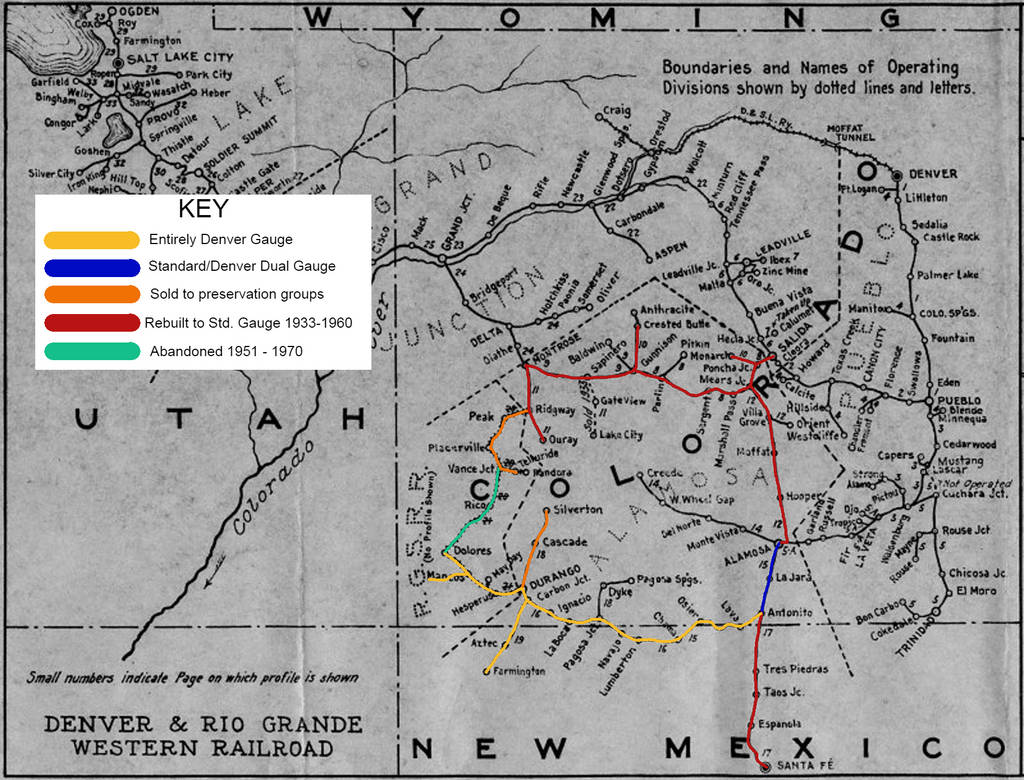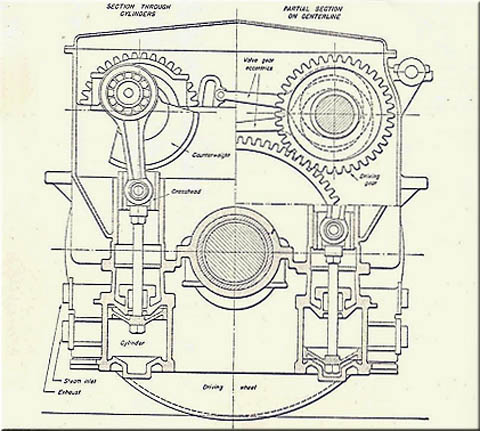Class 102 "Cavalier" Night Sleeper Train
Type: BiLevel Eight-Section Electric Multiple Unit
Builder: National Steel Car, Burlington, Ontario, Canada
Operators:
- Via Rail Canada (1975-2011)
- Ontario Northland Railway (1976-1996)
- British Columbia Railway (1976-2014)
Number Built: 78 Sets
Perhaps the example of Canada's do-it-right-the-first-time attitude applied to a train for Via Rail Canada upon its formation in 1970, The National Steel Car-built Class 102 was one of the first examples of the Via Rail Canada "Rail Rebirth Plan" approved by the Canadian federal government in 1971, aimed at dramatically improving rail passenger service in Canada after many years of relative decline (though, it has to be said, Canadian National Railways never gave up on the idea of successful passenger trains - but they were among the ones who pushed hardest for Via Rail's formation out of a belief that such a system would be beneficial for the passenger network as a whole) that followed the chaotic 1960s in Canada, which had seen the 1957-58 energy crisis and the building of the Japanese Shinkansen System (whose first line, the Tokyo-Osaka Tokaido Shinkansen, began operations in 1964) which as revolutionized rail travel in Japan and gotten attention all over the world. While Canada would eventually commit to the building of a high-speed system of its own, in 1971 the plan was to complete CNR's existing electrification plans and expand Via Rail's service offerings as much as possible, and the Class 102, based on a very good idea developed by civil engineering firm Stantec, architects Mathers, Haldenby and Katrovic and rolling stock manufacturer National Steel Car, was developed by the firms to fill one such idea - the idea of using CNR's newly-electrified main lines to run a dedicated electric multiple unit sleeper train on in order to replace the aging and increasingly-unreliable fleet of railroad passenger cars Via Rail relied on. Via's management - made up mostly of the passenger people from CNR as well as from Canadian Pacific - could see the idea's viability, and when Stantec, Mathers, Haldenby and Katrovic and National Steel Car made their pitch to Via Rail in April 1971 complete with preliminary designs for the car, it wasn't long before Via's management would sign off on it, the Class 102 joining the high-speed LRC trains (Class 101 to Via) as the beginnings of their new setup, along with orders for many new diesel and electric locomotives and new BiLevel passenger cars to replace aging existing rolling stock and the massive "Renaissance" program of passenger car rebuilding done by Via Rail, came to be the first stages of Via's path a much brighter future.
While the Class 102 wouldn't come out looking all that much like the drawings made shown off in 1971, the basic idea remained. The Class 102, like the new cars ordered by the thousands by Amtrak south of the border, were built as tall double-deck designs, but the similarities mostly stopped there. Built with stainless-steel frames and aluminum bodyshells for strength and corrosion resistance, the Class 102 was designed from the start as an electric multiple unit, complete with a full restaurant car and a full lounge car as well as six sleeping cars, with a mix of accommodations. These ranged from couchette-style compartments for four people, slumbercoach-style compartments, two family bedrooms, roomettes, double bedrooms and larger bedrooms. As these trains were designed from Day One to be for night sleeper services, much attention was put into the cars being quiet and smooth-riding even at higher speeds - the trains were designed to see speeds of up to 180 km/h in service - and were designed with excellent creature comforts, including every car (including the four-person couchette compartments) having wash basins and all cars having a shower and two bathrooms, while the better rooms had private washrooms. Two crew bunk rooms were a part of the design as well (primarily for porters and the dining car crew) and the end cars had baggage facilities to allow passengers to carry extra baggage on the trains.
The trains had six powered cars and two unpowered ones, with the end cars having pantographs above their driver cabs. The sets all originally had gangways to allow multiple sets to be coupled together, but later refurbishment added a complete nose to the front of each set, limiting the trains' multiple-unit capability to be limited to two units end-to-end. (This was uncommon in the 1970s but would become much more common with time.) The six-powered cars were equipped with four powered axles on each car, the twenty-four powered axles giving impressive acceleration (and as all were equipped with regenerative braking and disc brakes, their braking was as impressive as its acceleration) and a smooth ride, and after initial teething troubles were figured out, the train were basis of Via Rail Canada's "Cavalier Service" of night trains, reviving the name of CNR's famous night trains of previous times in 1980. While diesel-powered units were considered, the growing electrification of the Canadian railroad network (particularly in Eastern Canada where the ridership was highest) and the growing number of new sleeper cars as well as refurbished ones meant a diesel-powered Class 102 was never built, even though 65 sets would be built for Via between 1974 and 1978, and Ontario Northland and British Columbia Railway would add thirteen more units built (five for ONR, eight for BCOR) in 1978 and 1979.
The units' success was immediate. First introduced for Toronto-Ottawa-Montreal services in 1975, by 1980 the expansion of CNR electrification led to the Class 102s seeing service on services to Sudbury, Detroit, Quebec City and, following the completion of electrification along the former New York Central corridor along Lake Champlain in 1980, night trains from Toronto, Montreal and Ottawa to New York City, which began in April 1981. Offering most of the comfort of a hotel room but without the expense of one (and the price of tickets on these trains included a dinner and a breakfast as part of the price), the trains by the early 1980s were extremely popular, so much that Via Rail Canada by 1984 had capacity issues, and with the building of the St. Lawrence River High-Speed Line underway by then and the prospect of the huge costs of the line and dedicated new rolling stock, Via Rail was forced to begin the process of integrating modern sleeping cars in between two Class 102s as part of a train. Despite this extra weight the power of the units meant they maintained schedules just fine, and Via committed to an upgrade program for them beginning in 1989, all 65 sets cycling through the rebuild program between the summer of 1989 and the spring of 1991, the improvements including the ability to have additional BiLevel coaches between the sets as well as many additional amenities - all rooms gained satellite radios and available headphones, power outlets, clocks with an available alarm function and better night lighting. Some 40 of the sets would lose their dedicated dining cars in favor of a three-unit Restauranteur dining car set integrated between the two units along with two additional sleeping cars, giving in this guise a 21-car setup that was known to Via Rail as the Class 102E, while all the ONR and BCOR sets would follow the Via Rail units through the shop in the early 1990s, gaining many similar improvements to the Via Sets. BCOR sets got an additional change when, thanks to the expertise of Pacific Rolling Stock in New Westminister, British Columbia, their lounge cars gained panoramic roofs in 1996.
With the completion of the first section of the St. Lawrence River High-Speed Line in 1986 and the opening of the Wildrose Express Line in early 1988, rail travel in Canada began a massive expansion that Via would spend nearly two decades grappling with, though successfully doing so through a vast investment into its services. The new high-speed line that grew almost every year between 1986 and 2007 would be the new turf for all 65 of Via's Class 102s, and the company ordered a new series of double-deck sleepers, the Class 115s, in 1994 first to complement and then ultimately to replace the Class 102s, though it was clear even then that wasn't gonna be any time soon for cost and growth reasons. The Class 115s, built by Bombardier Transportation as night train sets in 8, 10, 12 and 16-car sets, were designed from the start to be able to run with a Class 102 and with Via's increasingly-large fleet of sleeper cars equipped to run with the powerful electric multiple units. The electrification of CPR's Sault Ste. Marie secondary and the Algonquin division of CN between Pembroke and Mattawa, Ontario in the early 1990s extended the already-expansive reach of the sleeper units, and by the mid-1990s Via Rail Canada offered the Cavalier service as far as Chicago and Halifax, and some 82 of the Class 115s were ultimately built to run with the Class 102s.
By the early 2000s, the Class 115s were joined by the Stadler-built Class 118s, originally designed specifically to allow the now 25-year-old Class 102s to begin to be retired, but Toronto's winning of the 2008 Olympics in 2001 meant that the demand was going to be huge for a while yet. Indeed, the 2008 Olympics would be one of Via Rail's finest hours, as demand for American visitors to Toronto in July 2008 was immense, dwarfing even the 1976 games in Montreal, and the absolutely-massive numbers of tourist arrivals from the United States, combined with Amtrak's increasingly-big Midwestern High-Speed Networks, meant that the Class 102s, 115s and 118s and their suitably-equipped passenger car backup could be seen as far out as Washington, St. Louis and Nashville, running services to Toronto for visitors to the Olympics. After the Olympics the oldest Class 102s began to be retired, the last ones exiting Via Rail Service in October 2011 after 36 years of faithful service.
Ultimately parts of five Class 102s would be preserved, three at museums in Canada, a full set donated to the Americas' Rail Museum in New Jersey and a fifth full set to the National Railway Museum of the United Kingdom in York in the UK.



